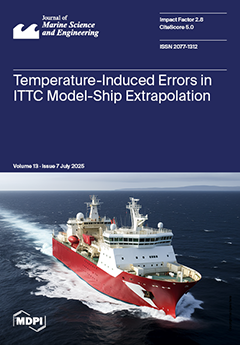The study of the impact of anthropogenic and natural pollution on living organisms has become a major social issue. In this context, the objective of this work is to assess the use of the polychaete annelid
Hediste diversicolor as a bioindicator organism for
[...] Read more.
The study of the impact of anthropogenic and natural pollution on living organisms has become a major social issue. In this context, the objective of this work is to assess the use of the polychaete annelid
Hediste diversicolor as a bioindicator organism for the quality of the marine environment. The concentration of four heavy metals (lead, copper, zinc, and cadmium) was determined in natural populations of
H. diversicolor captured from four locations along the Tunisian coast using atomic absorption spectroscopy. Concentration ranges (µg/g dry weight) across all sites were as follows: Cd (0.12–0.43), Cu (3.80–6.45), Zn (18.35–42.78), and Pb (22.64–63.91). Statistical analysis confirmed significant spatial variation (Pb: F = 12.15,
p < 0.001; Zn: F = 3.32,
p = 0.04; Cd: F = 48.66,
p < 0.001; Cu: F = 9.08,
p < 0.001), with peak Pb in Bizerte and Cu in Sfax. These results highlight the influence of local environmental factors, such as industrial and urban pollution on metal accumulation in
Hediste diversicolor. In this study, the accumulation of the analyzed elements in the tissues
of H. diversicolor follows an increasing order as follows: Cd < Cu < Zn < Pb. Additionally, lead metal concentrations were higher than those of cadmium, zinc, and copper for all four studied locations. To our knowledge, this is the first study in Tunisia to assess heavy metal accumulation in
H. diversicolor. The recorded levels were similar to, or lower than, those reported in other studies worldwide. These findings underscore the potential of
H. diversicolor as a sensitive and effective bioindicator for monitoring coastal contamination and guiding environmental management strategies in Tunisia.
Full article





